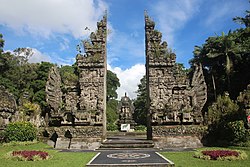This article needs additional citations for verification .(September 2018) |



A gate or gateway is a point of entry to or from a space enclosed by walls. The word is derived from Proto-Germanic *gatan, meaning an opening or passageway. [1] Gates may be designed for decorative or functional purposes, and they vary widely in style depending on architectural trends and material choices. [2]
Contents
Synonyms include yett (which comes from the same root word) and portal. The concept originally referred to the gap or hole in the wall or fence, rather than a barrier which closed it. Gates may prevent or control the entry or exit of individuals, or they may be merely decorative. The moving part or parts of a gateway may be considered "doors", as they are fixed at one side whilst opening and closing like one. [3]
A gate might have a latch that can be raised and lowered to both open a gate or prevent it from swinging. [4] Gate operation can be either automated or manual. Locks are also used on gates to increase security.
Larger gates can be used for a whole building, such as a castle or fortified town. Doors can also be considered gates when they are used to block entry as prevalent within a gatehouse.

































